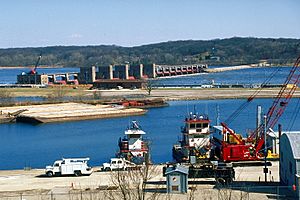Lock and Dam No. 14 facts for kids

Lock and Dam No. 14 on the Mississippi River. View is from the Iowa side looking across the river to Illinois.
|
|
| Location | Hampton, Rock Island County, Illinois / LeClaire Township, Scott County, Iowa, near LeClaire, Iowa, USA |
|---|---|
| Coordinates | 41°34′21.75″N 90°23′54.02″W / 41.5727083°N 90.3983389°W |
| Construction began | 1921 (6 ft project) |
| Opening date | May 13, 1938 (9 ft project) |
| Operator(s) | |
Quick facts for kids Dam and spillways |
|
| Impounds | Upper Mississippi River |
| Length | 2,700 feet (823.0 m) |
| Reservoir | |
| Creates | Pool 14 |
| Total capacity | 82,000 acre⋅ft (0.101 km3) |
| Catchment area | 88,400 sq mi (229,000 km2) |
|
Lock and Dam No. 14 Historic District
|
|
| Lua error in Module:Location_map at line 420: attempt to index field 'wikibase' (a nil value). | |
| Location | 25549 182nd St., Pleasant Valley, Iowa |
| Area | 304.3 acres (123.1 ha) |
| Built | 1939 |
| Architectural style | Moderne |
| MPS | Upper Mississippi River 9-Foot Navigation Project MPS |
| NRHP reference No. | 04000174 |
| Added to NRHP | March 10, 2004 |
Lock and Dam No. 14 is a special structure on the Upper Mississippi River. It helps boats travel safely and manages water levels. This important site is located near Le Claire, Iowa, between Iowa and Illinois.
Contents
What is Lock and Dam No. 14?
A lock and dam system is like a giant water elevator for boats. The "dam" part holds back water, creating a higher water level. The "lock" part is a chamber that fills with or empties water. This allows boats to move between different water levels.
Lock and Dam No. 14 is a key part of the Upper Mississippi River navigation system. It helps ships and barges move goods along the river. The movable part of the dam is about 1,343 feet (409.3 m) long.
How it Works
The dam has 13 tainter gates and 4 roller gates. These are like big doors that can be opened or closed to control the flow of water. They help keep the river at the right depth for boats.
Next to the dam is a long rock wall, about 1,127 feet (343.5 m) long, that reaches the Illinois side. The main lock, where boats pass through, is 110 feet (33.5 m) wide and 600 feet (182.9 m) long. This is large enough for many big river vessels.
A Bit of History
The construction of Lock and Dam No. 14 happened in two main stages. The first stage, from 1921 to 1924, was part of a "six-foot channel project." This project aimed to make the river at least six feet deep for easier boat travel. During this time, a lock and a canal were built to help boats get around dangerous rapids.
The second and larger stage took place from 1935 to 1939. This was part of the "nine-foot channel project." This project made the river even deeper, to nine feet, allowing bigger boats to use it. This phase included building the main dam and the current large lock we see today.
A Historic Landmark
Lock and Dam No. 14 is not just a working structure; it's also a historic site! It was added to the National Register of Historic Places in 2004. This means it's recognized as an important place in American history. The historic area covers about 3,043 acres (12.3 km2).
Home to Wildlife
During the colder months, the area around Lock and Dam No. 14 becomes a popular spot for bald eagles. These majestic birds often gather near the open water below the dam to find food. It's a great place for wildlife watching!
Images for kids
| List of locks and dams of the Upper Mississippi River | ||
|---|---|---|
| Upstream: Lock and Dam No. 13 |
Downstream: Lock and Dam No. 15 |
|


